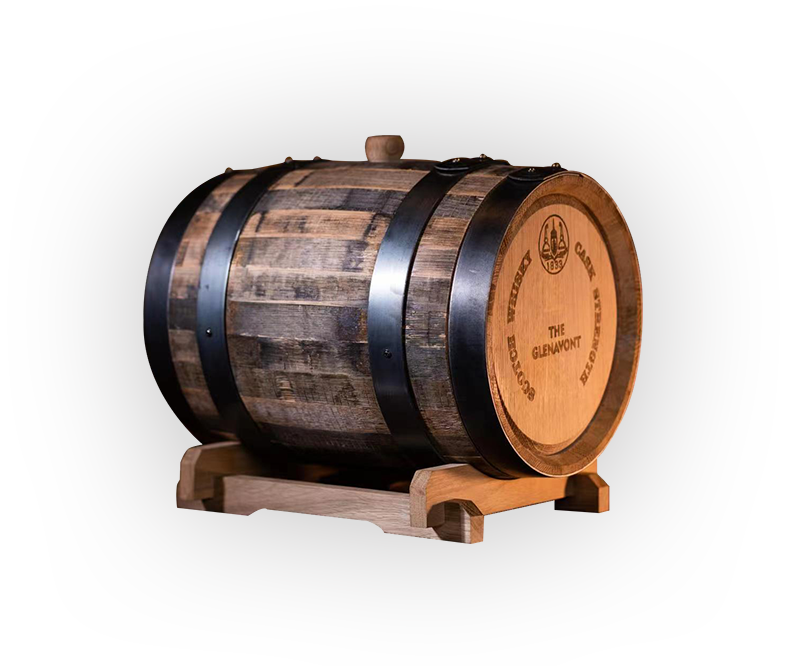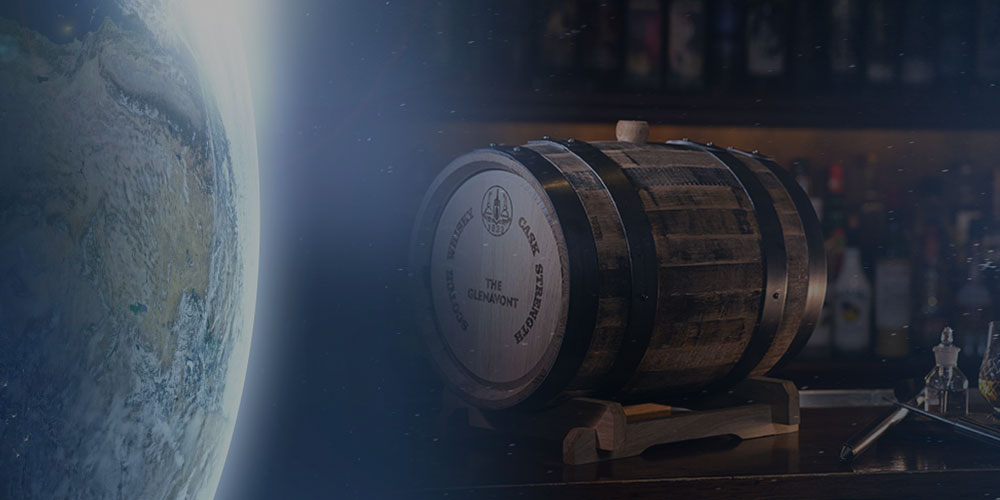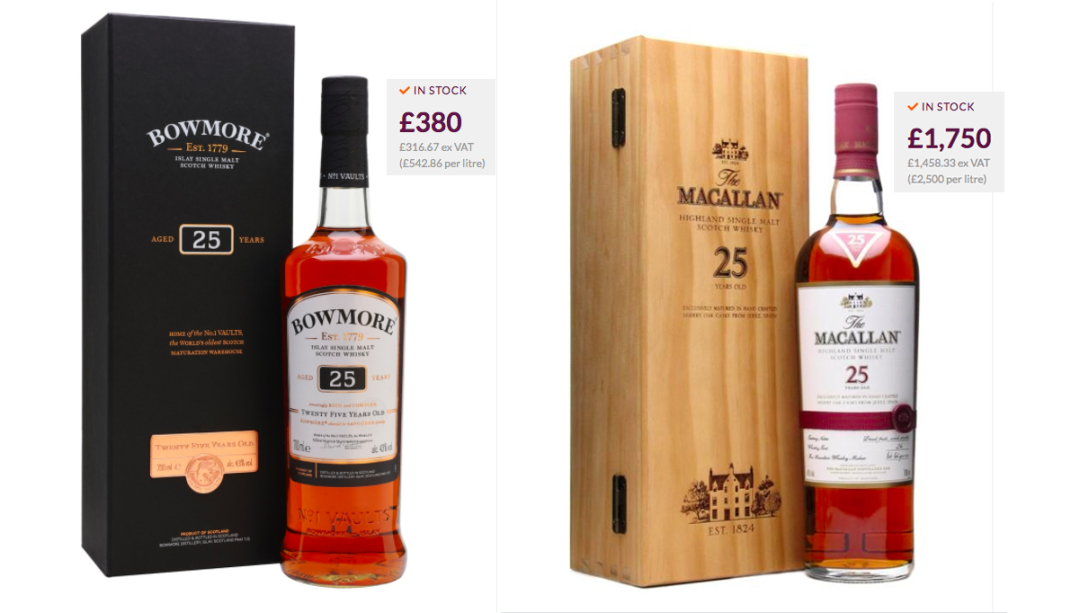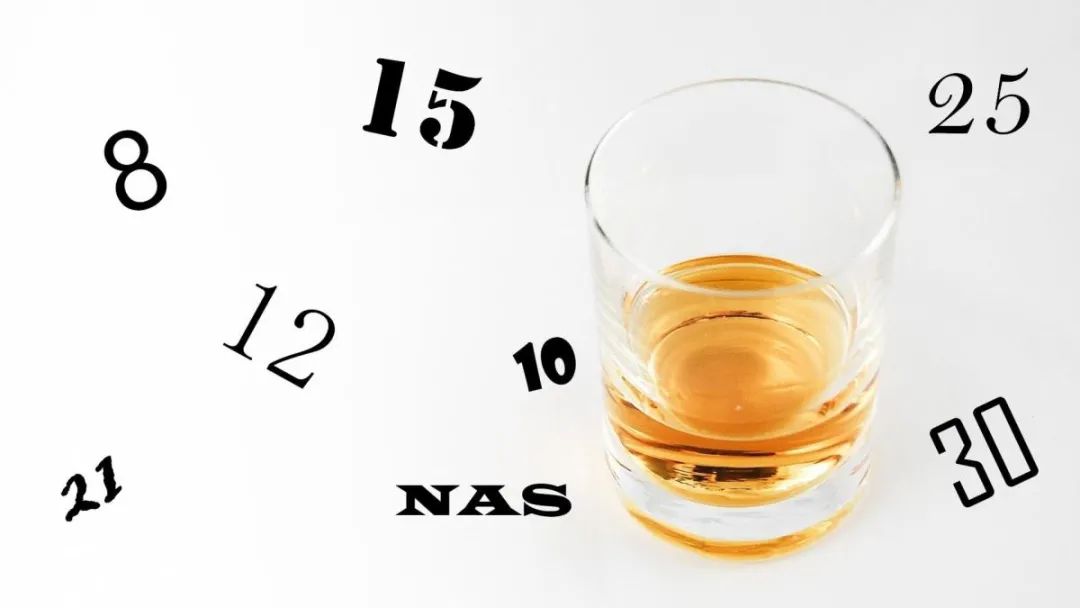




Looking through private messages today, I found a kind of common questions-why is this XX brand so much more expensive than other XX brands on the Internet for 20 years? For example:

The price difference between mccarron 25 years and Pomo 25 years is several times.
Indeed, for drinkers who don't know how to drink, they can only judge the price according to the most straightforward year. But in fact, this is a very common misunderstanding. Even our purchasing younger sister thinks so. It is conceivable that it takes a lot of breath to find out this matter. But today, Xiaobian threw caution to the wind and made it clear-why is the price of whiskey of the same year so much worse?
People who judge the value of a wine by its vintage think that the older whiskey is, the better it is. So first, let's discuss:
01 Why isn't the vintage of whisky as old as possible?
When we talk about whisky, in fact, we often taste the balance between the original New Make (that is, the transparent new wine just distilled) and the barrel flavor.
Crossing barrels is a double-edged sword. On the one hand, oak barrels can give New Make more layers and flavors; However, for high-aged whisky, we should also be careful not to have too flamboyant barrel flavor.
There is a saying that "the shape of the distiller determines the style of the winery", and the style here refers to the style of New Make.
For many whiskies, 18 years is a turning point.
18 years ago, the characteristics of whisky distilleries were greater than that of barrel aging. After 18 years of aging, the characteristics of whisky distilleries gradually weakened, barrel aging was obviously prominent, and the flavor of liquor was more complex, while still retaining good vitality. Drinking whisky drinkers generally agree that 18 years is the golden age of whisky.
After 18 years, the characteristics of whisky distilleries have gradually weakened, the barrel aging characteristics have become more and more prominent, and the flavor is still changing, but not all of them are changing for the better, or it is possible that it tastes like wood only.
The storage location of oak barrels also has a great influence. The latitude and climate of the wine cellar will affect the proportion of Angel's Share. Scotland's climate is humid and cold, with angels enjoying about 3% for the most part. Taiwan Province has a subtropical climate, with angels enjoying 12%-15%. That's why Taiwan Province whisky can be aged for 10 years after being aged for 3-4 years.
Therefore, judging the price of whisky by the year is simply unreliable. So—
02 What determines the price of whisky?
First of all, the production cost and the relationship between supply and demand jointly determine the price of whisky, or to put it bluntly, the market. The price of whisky is still in line with the laws of economics, and "scarcity is precious" is everywhere.
In recent decades, the price of whisky in OB Scotland has been very stable, and if inflation is taken into account, the price has even dropped somewhat. However, the prices of IB and rare whiskey are rising.
As far as OB is concerned, the price and year of whisky are generally positively correlated, but not directly proportional.
Let's look at a picture first:

The horizontal axis is the age of whisky, and the vertical axis is the price.
Red dot: representing 60 best-selling single malt whiskies;
Green line: connecting the cheapest whisky of every wine age;
Blue line: connecting the most expensive whisky of each wine age;
Black line: It is the average price of each wine age segment.
The volume of these whiskies is 700ml, and the ABV is 40-46%. Of course, there are more expensive and cheaper whiskies in every wine age, but this chart only selects the best-selling brands.
Look at the table carefully, and you will find that the facts may be different from what you thought before. It's quite common that the younger ones are more expensive than the older ones. Even the average price in 10 years is higher than that in 12 years. Every year, there are brands with higher prices than the older ones. Even after 21 years, there is no extreme growth like the luxury goods market.
Why is the average price of 12 years cheaper than that of 10 years? This is a problem left over from history.
In 1890, Chivas)12 was born in 12 years. Before that, whiskey was only distilled in XX years and bottled in XX years. This is the first bottle with the age number. So "12 years" has become a classic symbol since then.
In the 1960s, because of the fierce competition in the blended whisky market, all major brands reduced the purchase amount of raw wine from whisky distilleries. As a result, these distilleries had to make their own living and began bottling the raw wine directly.
In 1963, Granfeldi introduced the first single malt whisky in the modern sense. After that, other distilleries followed suit, and in order to save the publicity cost, they all chose it for 12 years.
However, in this way, the market supply of single-malt whisky in the past 12 years has been greatly increased, and the supply exceeds demand, which has led to fierce competition. As a result, the price war has started, and no one can sell it more expensive. In the end, it's worth 12 years but not 10 years.
It can also be seen from the figure that the price increase in 12-15 years was relatively gentle, but the increase in 15-18 years suddenly increased by more than 1 time.
As I said just now, 18 years is the golden age of whisky that most people agree with, and the natural demand is high. The price of whisky in this year is relatively dominant in wineries, so the price of 18 years and 12 years is certainly out of proportion.
The audience of whisky becomes narrower and more expensive as it gets older, mainly because of its low output and high cost. The longer the whisky is stored, the more labor cost, storage cost, oak barrel cost and angel's enjoyment will be lost. The wool comes from the sheep, and these costs, of course, have to be added to the price for you.
Less output, on the one hand, is the loss enjoyed by angels; On the other hand, old-age whiskey may be used as the base wine of non-aged or low-aged whiskey because of excessive barrel flavor or improper storage. Only a few high-quality high-vintage whiskies can be bottled and marketed independently.
Generally, whiskey over 21 years old has collectible value besides being used for drinking. Especially in the very old or rare years when famous brand wines are produced, the price has completely exceeded the value of whisky itself.
03 What other factors will affect the price of whisky?
Think of whiskey as recruitment, and it's easy to understand it.
For example, does a job seeker with 10 years' work experience have to earn more than 5 years' salary? Of course not. What if the 5-year-old one is from Tsinghua?
So, what if both of them have the same education and work experience of 10 years and 5 years?
This is not necessarily the case, because five years is a short time, but people may have gone to the investment bank just after graduation, and in just a few years, they have been promoted to middle management, while those who have been in 10 years may have just become group leaders in a good company.
Change to the language of whiskey, if the year = years of work experience, then maybe the distillery = graduation college, mature in the barrel = what internships have you done and which major has you taken, IB= which company you went to after graduation, and single barrel = outstanding graduates who have been directly pushed in.
In addition, if there is a famous teacher's advice (famous winemaker, bartender, bucket picker, etc.), it will be gilded. If an individual still has his own personality and specialty (such as barrel strength, non-condensation, no addition, etc.), of course, his value will have to rise again. In addition, multiple certificates (such as winning a prize in a competition), recommendations from industry authorities (high scores from professional wine critics) and even good looks (special wine labels or bottle designs) are all bonus items ... Do you suddenly see the light when you think about it?
Salary is not only related to years of working experience, but also the price of whisky has many factors beyond years.
We are talking about the article about single barrel whiskey (please poke here for review: I spent tens of thousands of dollars on a world-first single barrel whiskey class. Can you help me see if it is pitted? ) said that the price of a single barrel of whisky is affected by both micro and macro factors. In fact, whether it is a single barrel or not, the price is affected by these factors.
Micro-factors refer to various factors related to the winery and the wine itself.
For example, which distillery or IB it comes from, how old the wine is, what barrel it uses, whether it has peat flavor, etc., that is, those factors mentioned above.
Everything else is easy to understand, but there are often readers who can't get around OB and IB, so let's talk about it in detail.
First of all, once a barrel of wine is bought by IB, it has nothing to do with the original distillery.
Because 70% of the flavor of whisky comes from oak barrels, the flavor is different with different barrels. Even if it comes from the same distillery, the wine left in the original OB, the wine sold to IB No.1, and the wine sold to IB No.2 will definitely taste different.
IB wine has no original OB DNA, and they don't need to consider OB DNA when choosing wine, because IB doesn't need to maintain the so-called winery style. If you buy a bottle of IB wine, you won't be able to drink the original OB style in high probability. Therefore, as a consumer, when buying IB, you don't have to be too obsessed with which distillery it comes from.
In addition, IB has its own reputation, and will also design its own bottles and labels of whisky, which are the points of price increase. If IB is better than others, it is normal to sell more expensive prices than other IB.
For example, Lehua wine merchants also buy grape wine from other grape farmers, but the price of Lehua wine will be much lower than that of other wineries that buy grapes from the same grape farmers.
After talking about micro factors, let's talk about macro factors.
Macro factors refer to the big environment.
It's like if the whole employment environment is not good, then everyone's salary will not be high; Not only that, but it's also ten years of hard work. Some industries just earn more than others.
The same is true of whiskey. Global or regional economic fluctuations, major political events, changes in laws and regulations and other things that cannot be interfered by human beings will have a huge impact on the price of whiskey.
For example, why Riwei is so expensive now is largely due to the economic depression in Japan a few decades ago, which led to the closure of many wineries and the failure to preserve the old wine. It took decades for this influence to manifest itself. By the time the economy gets better and consumers begin to understand whiskey and want to buy Riwei, they will be gone!

All in all, besides the year, many factors, such as the reputation of distillery, IB brand, production cost, market environment, historical background and so on, will affect the price of a bottle of whisky. You can see a lot of information from the price of whisky, but you can't tell whether it is to your taste. So, instead of clinging to the vintage, go after the whisky you really like!

TEL:4006569976
WECHAT:THE GLENAVONT
Copyright GLENAVONT CO.,LTD All Rights ReservedKEEP ON RECORD :鲁ICP备xxxxxx号-xTECHNOLOGY :DaauuSITEMAP


